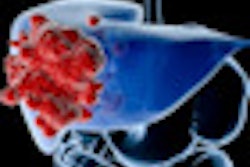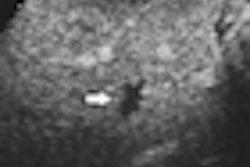
MRI can classify hepatocellular adenoma (HCA) into precise subgroups, and has become a robust diagnostic tool that is of great importance because HCA management is related -- aside from gender and tumoral size -- to the subtype, according to a top research group from France.
"In our experience, MR correctly classifies HCA subtypes in 85.1% of cases, using all of which presented signs. The interobserver correlation is excellent," noted lead presenter Dr. Maxime Ronot, from the department of medical imaging at Beaujon Hospital and Paris VII University, Clichy, France, at the 2012 European Society of Gastrointestinal and Abdominal Radiology (ESGAR) annual meeting in Edinburgh, U.K. "The few studies about HCAs and hepatospecific contrast agents at MR, such as gadoxetic acid, focused on differentiating HCAs from other benign hepatocellular lesions, mainly focal nodular hyperplasia. No published data exist on HCA subtyping performances using hepatospecific contrast medium."
Ronot and his colleagues have found that on diffusion-weighted MR images, benign hepatocellular lesions often show findings that suggest restricted diffusion.
HCAs are rare benign monoclonal proliferation of hepatocytes, and are more common in young women taking oral contraceptives. The prevalence in the general population is 0.03%, and the lesions are more frequent in women (sex ratio of 9:1), he noted. The use of oral contraceptive is reported in around 85% of cases, and the risk increases with the duration and estrogen content of the contraceptive.
HCAs can also occur in men, mainly those receiving anabolic steroids, he explained. Among the underlying metabolic diseases associated with HCAs are type I and III glycogen storage disease, tyrosinemia, galactosemia. The prevalence of obesity is high in patients with HCA. One-third of patients have multiple HCAs, and patients with more than 10 HCAs are subclassified in a so-called liver adenomatosis. Multiple HCAs tend to occur mostly in females using oral contraceptives.
"Patients are exposed to hemorrhagic complications or malignant transformation," stated Ronot, whose key interests are in abdominal imaging, mainly liver fibrosis and tumors, and in interventional abdominal oncology; he also works in the laboratory of physiologic and molecular MR of the abdomen in Paris (INSERM U773). "Patients with hepatocellular adenoma can present with symptoms, but 80% of patients are asymptomatic. HCA can be revealed by acute abdominal pain related to intratumoral bleeding, and sensation of right upper quadrant fullness or discomfort (large)."
Risk of hemorrhage risk depends on the size and the subtype of the lesion, and in cases of significant hemorrhage, patients may suffer from acute intense abdominal pain, he added. Bleeding may lead to subcapsular or intrahepatic hematomas and in cases of rupture, to hemoperitoneum and eventually to hypovolemic shock. Malignant transformation, on the other hand, can occur in about 10% of cases. Several risk factors are well-established: men (nearly 50%), large HCAs, more than 5 cm in diameter (12%), beta-catenin activation.
Management is based on the previous considerations. The therapeutic strategy is based on four elements, three of which are accessible to radiologists: size, subtype, gender, and β-catenin status. There is no definite consensus on HCAs management, but resection is indicated when the diameter size is greater than 5 cm, men are involved, and β-catenin activation occurs, Ronot explained.
In their ESGAR presentation, the researchers sought to expose recent developments in tumoral pathogenesis and subclassification in HCA, expose imaging findings in HCA related to tumoral subtyping, with special attention to MR findings, and review complications and patient management depending on the different subtypes of HCA.
"HCAs are now classified based on a new pathomolecular classification establishing the existence of several subtypes of HCA. This classification establishes the relationship between several gene mutations and different phenotypic expression," Ronot pointed out. "HCA is no longer considered as a uniform lesion but as a collection of different entities sharing common points but separated by different typical morphological aspects."
Prior to the identification of different subtypes, imaging features of HCAs were nonspecific: lesion heterogeneity, presence of fat and/or hemorrhage. It has been shown that the different molecular features correspond to distinct phenotypical features -- MR is the best imaging tool for lesion characterization.
Telangiectatic/inflammatory HCA (tHCA) is the most common subtype (46% to 54% of cases), and it corresponds to the entity initially described as "telangiectatic focal nodular hyperplasia." At histology, lesions are composed of inflammatory infiltrates, sinusoidal dilatation, and dystrophic vessels without fibrosis. Cellular atypias and intratumoral steatosis can be found, and it is associated with obesity (two-thirds of cases), hepatic steatosis (40%), and increased serum levels of acute inflammatory markers such as C-reactive protein (CRP), serum-amyloid associated protein (SAA), he noted.
β-catenin activated HCAs account for between 8% and 12.5% of HCAs. The percentage of men is much higher in this subtype (almost 40%). Specific risk factors associated with this group of tumors include glycogen storage disease, male hormone administration, and familial polyposis, and this group is the most exposed to malignant transformation, according to Ronot. Physiopathogeny is related to somatic mutations of CTNNB1 gene inhibiting β-catenin phosphorylation, nuclear activation of β-catenin target genes, and hepatocyte proliferation.
Nonspecific HCAs represent 5% to 11% of all HCAs, but no mutation is associated with this subtype. The lesion has no specific characteristics, and the imaging features are similar to those of β-HCAs, he concluded.



















